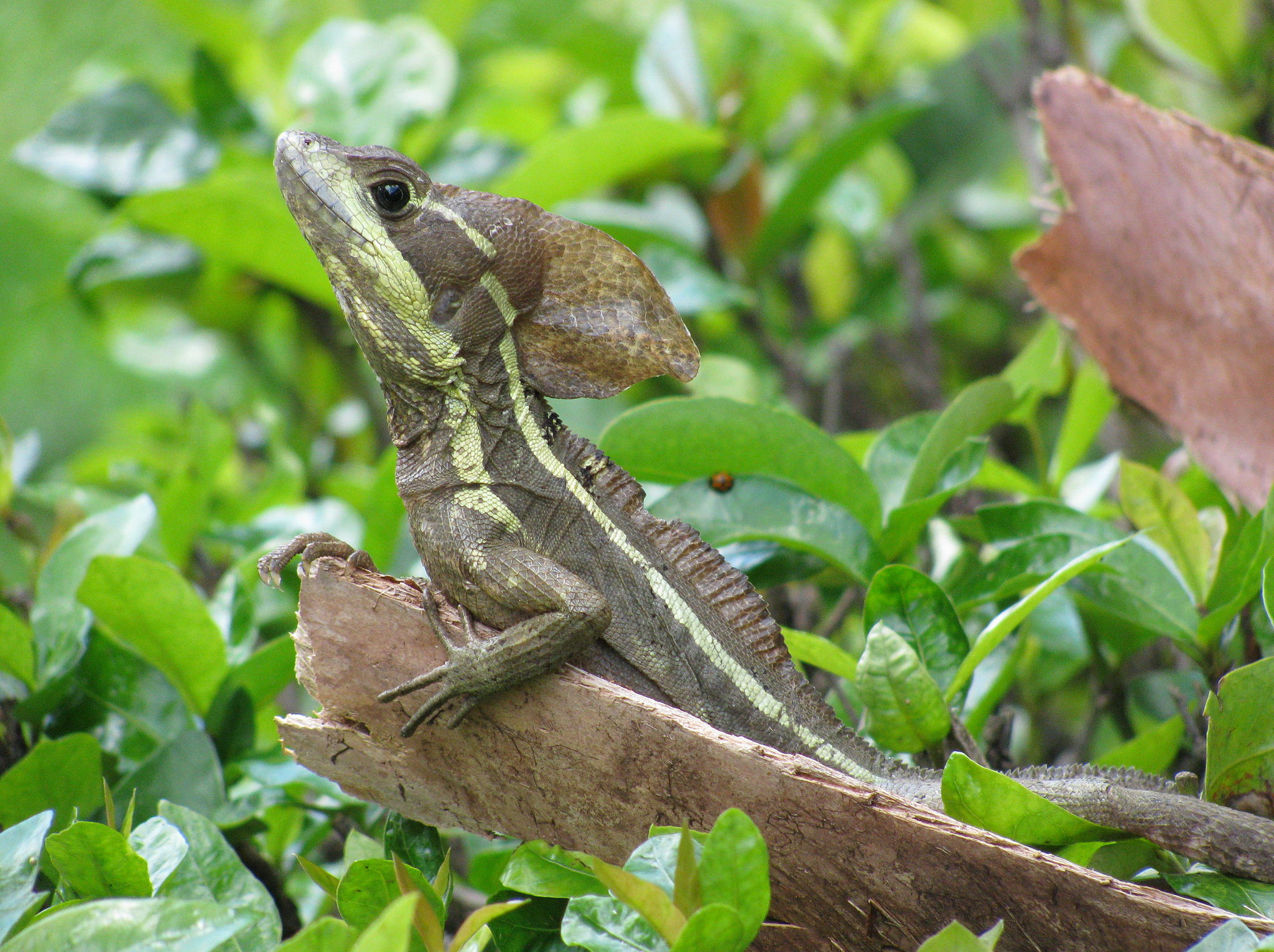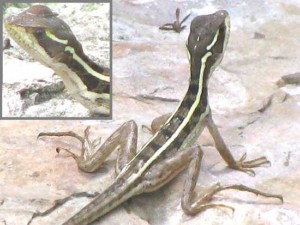I am not a religious person, but I do believe in miracles. If a miracle can be defined as something that we cannot explain, then believe me, my life is just full of them. I was approaching our sizeable fish and lily and hyacinth and turtle and dragonfly pond yesterday when a striped basilisk (Basiliscus vittatus) saw me coming and took off running on his hind legs straight across the surface of the water to the far bank and disappeared into the jungle.
It was a miracle straight out of Matthew 14:22, but I’m not going to a biblical place with this. Miracles, in my mind, have a very real place in evolutionary science as well. If you are a prey species like the basilisk, of whom only two percent survive to the two-year mark, you need an occasional miracle. Different species have evolved different ones. The flying fish can explode through the silvery overhead “sky” that the predator fish thought was the limit of the visible universe. The Caribbean reef squid can jet out a cloud of ink and then real quick change color and shape to look just like a cloud of ink next to the cloud of ink. The horned lizard can shoot caustic blood in twin streams out of his eyes for up to four feet, with considerable accuracy. These are evolution’s miracles. They are that last trick that you keep in reserve for when you’re really in trouble. They vary, but they all have the quality that they are so startling and unexpected that they leave the predator standing there with his jaw on his chest like Wily Coyote, while the prey disappears over the horizon. Scientists call them predator evasion adaptations. I call them miracles. For the basilisk, this is what it is: He can walk on water.
But their favorite place to hang out is near water, which is why they like the banks of our fish pond. That’s where they can avail themselves of their miracle. They have flaps of skin on their toes that open when they slap the water, and provide more resistance, and also trap air, which creates just a little buoyancy. They gyrate their legs in a circular three-part move of slap, stroke, and recover, and, being lizards, their hind quarters splay outward quite a bit, so that each slap is to one side and then the other, which keeps them stable as they run. This is actually fairly important—even if you or I were capable of running on water, we would pitch over to one side or the other because our legs are both directly underneath us. The outward thrust of their gait solves that problem, and it also gives them a very comical look when they run, and I always crack up when I see it. To invoke yet another cartoon, they remind me of the Disney character Goofy when he’s in full sprint.
But it’s exhausting work running on water, and they actually can’t make it terribly far. You might not realize it, but when you trot along a street or a running trail, you’re enjoying a huge re-use of energy as the impact of each step is stored, spring-like, in the connective tissue and muscles of your leg, and then released again into the next step. When you run on water you don’t get that. With each slap and stroke, the energy is hurled down into the water and is gone. Every stroke’s a new stroke. The power you put into it has to be unflagging. The basilisk can make it about ten feet on his hind legs, then another six or so on all-fours, and then he drops into the water and swims for it. Fortunately, they are good in the water too, and can swim, and even dive.
Unfortunately, they have predators in both places.
Though they look goofy to us, charging along with their hind legs windmilling out to the sides, if you look closer there is an admirable grace and agility in their movements. I’ve seen them leap off a chest-high garden wall without hesitation, and hit the ground running. They can also use the Jesus Christ technique to run across the top of a field of brush—also a pretty cute escape trick.
But believe it or not, there is something else about the basilisk that is even more amazing than that, and few people know about it. It doesn’t have the showmanship of running across a body of water, but it puts these lizards in even more rarified company. Here’s what it is: They have the most accurate directional hearing of any vertebrate. Which is pretty impressive when you consider that there are some sixty-five thousand species of living vertebrates. The basilisks are the undisputed champs over all of them. They are superior to about 64,999 other animals in what I call the art of not running the wrong way. They can instantly and with unrivaled accuracy answer the question, which direction am I being charged from. And when you’re a two-percenter, it’s really nice not to get that one wrong.
It sounds arcane, but if you’re either a science nerd or a musician (and I’m actually both), you might want to read on and find out how they do it, because it will blow your mind.
You and I can tell, in a vague sort of way, which direction a sound is coming from, but I’ll bet you never asked yourself how exactly your brain is able to tell you that. My first hunch was that probably the sound is louder in the closer ear. That’s true, and it’s called interaural intensity difference (IID), and it’s how we humans do it, but I’ll bet you also never asked yourself why exactly the sound is fainter in the far ear, and that’s where it gets interesting. It turns out that it’s not because of the difference in distance, which is usually only a tiny fraction of the total distance to the sound source. It’s actually because of a thing called diffraction, in which the sound waves wrap around the object and lose some of their punch in the process, and here’s the thing about diffraction: It stops working as the object gets smaller, relative to the wavelength of the sound. Our heads are twenty times the diameter of a basilisk head, so IID can give us at least a hunch which way a sound is coming from, but for a basilisk it’s pretty much worthless. Their heads are just too small to create any diffraction for most wavelengths of sound. The math is fun: The rule of thumb scientists use is that the ratio of the head size to the sound wavelength needs to be greater than 0.1, and you’d be surprised how big some sound waves are. Believe it or not, middle C on your piano keyboard has a wavelength of 51 inches, which for a basilisk with a half-inch head creates a ratio of 0.0098—not even close to working. The C that is four octaves below middle C has a wavelength of 69 feet. I actually already knew this kind of stuff because back in my musician days I had to set up my gear and make it work in all manner of places, and 69 feet does not even fit in some rooms I have played, which is why the bottom end of a band’s sound is always muddy in a small club.
Another technique some organisms use is the teensy time difference between the sound hitting the near and the far ear. This is called interaural time difference, or ITD. That also doesn’t work for small animals like the basilisk, because the time difference is simply too small.
So this is where it gets really good. Here’s what they do: Both their ear canals open into the mouth, so that the sound hits one eardrum, then passes through the mouth and hits the back of the other eardrum. So the vibration of the eardrum is the result of the difference between those two sounds. If both ears are equidistant from the sound source, each wave hits the eardrum simultaneously from both sides, and the sound is dampened. If, on the other hand, the sound has travelled, let’s say, half a wavelength farther to reach one of the ears, then the waves hit the front and back of the eardrum alternately and that thing really gets to vibrating and the volume takes a giant leap. Most often it’s something between the two, and one sound will be advanced or backed off only slightly from peak-to-peak synchronicity with the other. You musicians out there, especially you aging 1970’s-era rock musicians, might remember a gadget that was popular back then called a phase shifter (they’re still around), which would split your sound in half and then do this rhythmically to one of them, so that the background ambiance would sort of swoop up and down in pitch. It’s hard to describe, but you’d recognize it if you heard it. There’s every chance that the world of the basilisk sounds a lot like a Doobie Brothers track.
But the difference between the Doobie Brothers and the basilisk is that the basilisk actually does something critical and exacting with this phase shifting data, and his life depends upon it. The calculations are both swift and precise, and he does it with multiple wavelengths simultaneously (few sounds consists of just a single pitch). Phase shifting is quite pitch-dependent, and the basilisk has the system tuned to be most effective up in the high end, which is where sibilant sounds like swishing and crunching happen—the you’re-being-jumped sounds. Many creatures use this technique. It’s called a pressure difference receiver. Some use it not to avoid each other, but to find each other, and have it tuned more for the sound of a mate. And though the basilisks are the masters of it among the vertebrates, it’s actually the insects who get insanely sophisticated with it, taking sound in through two or three different portals, some of which are not even anywhere near the head, and passing them through “acoustical trachea,” and even putting the sound through double membranes in places to further exaggerate the time delays. The result is animals like the field cricket (family gryllidae), who can be in a meadow with dozens or hundreds of crickets and other insects, but hear each one individually by “seeing” its location. They call it three-dimensional hearing, or auditory scene analysis. What it does is it eliminates sound masking. Because they hear not just a sound, but also a spatial location, they can choose which sound they listen to, just like you and I can choose which object to look at. You and I just hear a big racket in that meadow, but to a cricket, those myriad insect sounds don’t mask each other any more than one painting on a wall masks the one next to it.
Now you know.
Sources:
http://www.backyardnature.net/mexnat/basilisk.htm
http://www.acoustics.org/press/154th/carr.html
http://news.nationalgeographic.com/news/2004/11/1116_041116_jesus_lizard.html
http://www.ncbi.nlm.nih.gov/pmc/articles/PMC4282874
http://www.ncbi.nlm.nih.gov/pmc/articles/PMC2580811
http://www.phy.mtu.edu/~suits/notefreqs.html
4 Comments
Comments are closed.




So interesting! Thanks, Randy–miss you guys!
Miss you too! Say hi to Monterey!
Randy, Great story and of course we have these fellows in our yard too. I don’t see them often but when I do and see them running I think wow they are fast. I watched one run through the jungle under brush so effortlessly without a miss step. At least one that I saw, only watched for a second or two ,then it was gone.
It really is astounding the sensory level of most of the animal world compared to us humans. Recently I was introduced to the world of Homing Pigeons. Those fliers find there way home day or night, east to west , west to east ,warm or cold ,high elevation to low elevations.Seems that there are theories but no real sure proof of how they get it done. Thank’s for the story on the Basilisks. I enjoyed the read as always,keep them coming. Thomas Morck.
Thanks, Thomas! I wonder if your basilisks know our basilisks? And yeah, those homing pigeons, and bird navigation in general, are amazing! I wrote an article about that once too (it’s here: http://www.randysplanet.com/2011/03/birds-magnetite-and-unkind-scientists/). There are still a lot of unknowns.